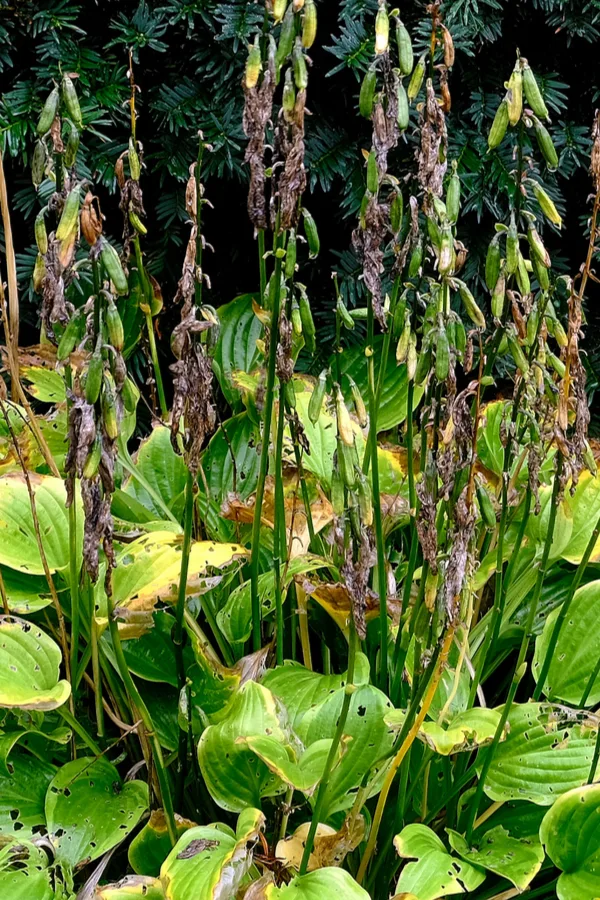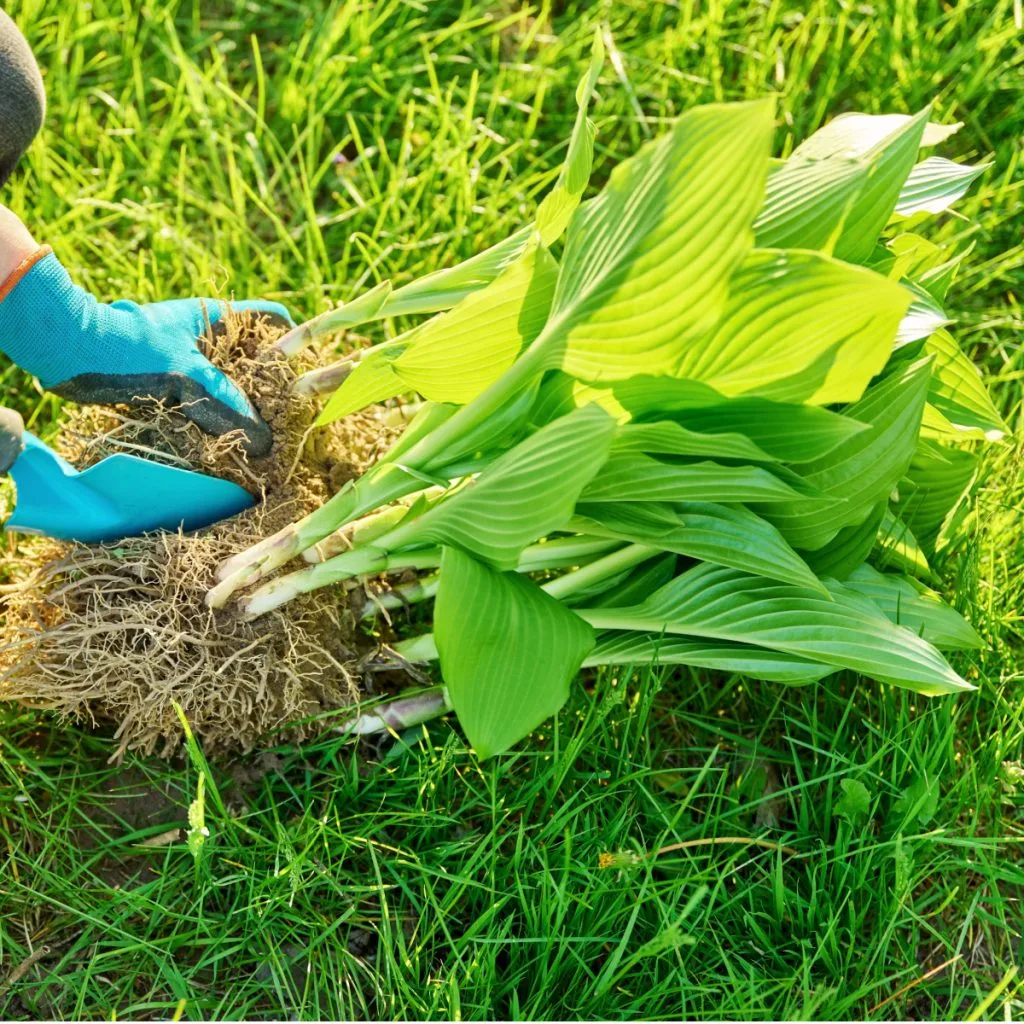As summer starts to see its final days, it’s time for a little late summer hosta care to keep your hostas strong for fall – and get them ready for next year!
Late summer and early fall are actually the perfect time for working with hostas. Whether it’s cutting back spent blooms and foliage, dividing oversized plants, or even moving plants to a new space – by getting plants in shape before the cold of winter, you can set the stage for great growth next year.
With that in mind, here is an in-depth look at autumn hosta care – including when and how to cut them back, how to divide and replant oversized hostas, and how to mulch them properly to protect them for winter.

Late Summer Hosta Care
By mid-fall, hosta plants usually begin to slowly lose their luster. Their long bloom stems become bare and brown. In addition to dying bloom stems, their once leafy, green, overflowing foliage starts to yellow and brown off as well.
Even worse, the foliage becomes a target for pests, which can decimate it quickly. All types of insects love hostas, especially late in the growing season. The large leaves are an easy target for pests, and along with the plant dying back, it can make for some pretty unsightly plants
Once all of this begins to happen, there is no ability for the plant to repair its foliage. When a plant reaches this point, it is time to take action and cut it back.
Cutting Back Hostas
So why is cutting back so important? For starters, decaying stems and leaves make for some pretty unsightly flowerbeds. But even more importantly, leaving the rotting foliage in your beds allows pests and disease a perfect place to find a home.
If kept around all winter, both can lay silently dormant. An unfortunately, in the spring, both can come back to life even stronger – potentially becoming a serious issue for all of the plants growing in your beds.
But cutting back plants early also allows you the chance to divide and transplant any hostas that have become overgrown. In addition, it is also the perfect time for moving or planting any transplants to new areas or beds.

Although these chores can be done in the spring as well, dividing and transplanting in the fall is the better choice. It allows the hosta crowns time to establish before winter, and sets the stage for full growth the following season.
Unfortunately, when transplanting in the spring, plants can lag a bit as they have to deal with the hot summer conditions as they set their roots. But with fall planting, they are ready to grow right from the start.
Cutting Back Fast & Quick
The good news is, cutting back hosta plants couldn’t be easier. The loose foliage and stems cut easily with garden shears or even a sharp pair of scissors. Simply lift up the foliage, and snip the plant to within a few inches of ground level. Product Link : Garden Shears
As for the foliage, as long as it does not show obvious signs of disease or pest infestation, it’s a great addition to the compost pile. Now that the plant is cut back, it’s time to determine if your hosta needs to be divided.
Splitting Back & Dividing
As stated previously, fall is the perfect time to dig up and divide overgrown hostas. Plants whose roots have become too large will not only bloom less in subsequent years, but become more susceptible to pests and disease.
When a hosta plant grows too large, its roots become crowded. As this happens, it has more and more difficulty absorbing both water and nutrients from the soil. That, in turn, results in a weaker plant that can struggle to grow and bloom.

A good rule of thumb for hosta plants is to divide them every 3 to 5 years. If your plants have become overly large and are having trouble blooming, now is the time to dig them up and divide!
To divide overgrown plants, start by first cutting all of the foliage back within a few inches of the ground. Next, remove the plant by digging around the outer edges and lifting the plant’s roots out. Don’t worry if you slice or hit a few roots in the process. Hostas are actually quite resilient and can handle a bit of damage.
How To Care For New Hosta Transplants In Late Summer / Early Fall
Just a quick note on late season transplants. Depending on the weather, new divisions and transplants may send up new shoots before winter sets in. This is completely normal and does not hurt the plant in any way.
It simply means that the roots have become well established in the cool, fall soil. A hard frost or freeze will eventually kill back the new growth, and the plant will head into dormancy for the winter months.
One thing you should not do in the fall is fertilize your hosta plants. Fertilizing can promote too much growth, especially if the temperatures happen to stay warm. Instead, as you will see below, you can provide a bit of slow-growth nutrients with compost.

Mulching For Winter Protection
Once plants have been cut back and any divisions and transplants needed have been accomplished, it’s time to give the plants a protective layer of mulch before winter.
The fall mulching of hosta plants is one of the most underrated chores of all, but it really can make a big difference in keeping perennials strong. Mulch helps insulate the plant’s roots against temperature swings. Swings that can cause excessive freezing and thawing that can injure or even kill off plants.
In addition, mulching also helps keep competing weeds and weed seeds from blowing in and taking over. See our article: Mulching Fall Flowerbeds, How To Stop Next Year’s Weeds Now.
For fall mulching, begin by putting a light covering (1 inch) of compost over the crown of each plant. Next, place a two to three inch layer of traditional mulch all around the plant.
Why the compost? Not only will the compost provide a bit of insulation, it also acts a slow release fertilizer for plants come next spring. It is especially helpful for new divisions and transplants to have added nutrients come spring.
Here is to giving your hostas a little care in late summer and early fall – and enjoying healthy blooming plants next spring!
This Is My Garden
Follow Our Facebook Page For Great Gardening Tips And Advice! This Is My Garden Facebook Page
This Is My Garden is a garden website created by gardeners, for gardeners. Jim and Mary Competti have been writing gardening, DIY and recipe articles and books and speaking for over 15 years from their 46 acre Ohio farm. They publish three articles every week, 52 weeks a year. Sign up today to follow via email, or follow along!
